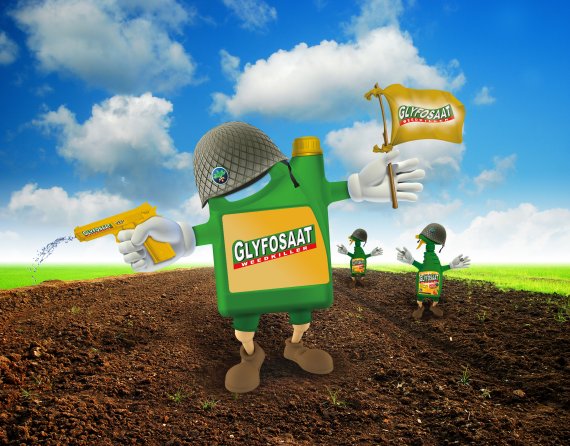illustration: Geert-Jan de Bruins
Opposition to glyphosate (sold under the brand name Roundup, among others) has increased considerably in recent years. It is alleged to be carcinogenic, cause damage to the liver, harm aquatic life and affect bees’ sense of orientation.
The evidence for this is not strong. The herbicide is not on the EU’s ‘list of candidates for substitution’, which lists hazardous substances that have not yet been banned. Unlike fipronil, which is used legally to deal with fleas in cats and dogs. Nor does glyphosate appear among the top ten most damaging substances in the Atlas of Pesticides in Surface Water. Unlike the insecticide imidacloprid, for instance, where there are much clearer links to damage in aquatic life and insects.
No debate
And yet there are few other substances that are as reviled as Roundup. Only a few weeks ago, WUR researcher Violet Geissen in the Soil Physics and Land Management chair group put her oar in as well. She published a study that showed that glyphosate can be found in almost half of all agricultural land and that it can spread more easily by wind and water than was previously thought. She advocated a ban, even though her study does not say anything about the ecological risks from glyphosate remnants. She also said that there were lots of traces of other substances too, although the data on this have not yet been published.
Why does Roundup keep getting lambasted? Paul van den Brink, researcher at Wageningen Environmental Research and professor holding a personal chair in the Aquatic Ecology and Water Quality Management group, thinks he knows why. ‘Monsanto, which produces Roundup, barely engages in the scientific debate at all. They just claim their herbicide is safe and are not prepared to investigate this properly. Other manufacturers are not quite as bad. They do at least attend scientific conferences and take part in the debate.’
Genetic modification
What is more, many of the environmentalists who oppose herbicides and pesticides are also against the use of genetically modified crops. That generally leads to complex arguments full of contradictions because the genetic modification of plants can reduce the need for herbicides and pesticides. But opponents see the ‘two evils’ united in Roundup. In the US, the herbicide is often marketed in combination with GM crops. ‘They are resistant to Roundup so their cultivation has become highly dependent on that herbicide. Whereas we want agriculture to become less dependent on chemical crop protection,’ explains Bert Lotz, team leader at Wageningen Plant Research. ‘This has damaged the weed killer’s reputation, even though that combination of variety and herbicide is never used in Europe.’
Lotz has seen the debate about Roundup become more entrenched in the past few years. About ten years ago, his team compared the herbicide with other weed control methods. ‘Drinking water companies were finding it in the surface water and wondered whether it should be banned. The manufacturer Monsanto thought not because the measured concentrations were comfortably below the ecological risk threshold. We were then commissioned by Monsanto and the drinking water companies to look at what would be the best option.’
Absence of nuance
His team recommended using the herbicide less and taking measures to prevent it ending up in the surface water. Lotz: ‘If you use the herbicide occasionally, that already has a big effect on the weed pressure; you can then use mechanical weed control methods and concentrate more on prevention in the intervening period. Assuming that the weed killer is safe (I leave that decision to the authority in charge of approval), we concluded that alternatives would be more harmful as they scored worse in a life-cycle analysis, especially on air quality. I still stand by that conclusion. But I can’t see us doing that kind of research again in the near future. There’s no more room for fine distinctions in the debate. The drinking water companies simply think the herbicide should be banned. No one is interested in further research.’
Lotz deplores the total absence of nuance. ‘Everything is so extreme. Either the weed killer should be banned outright or it should be approved for use for at least another five years. I’d prefer to see an intermediary solution where the approval could be withdrawn again on the basis of interim studies.’
Dosage option
Various other WUR researchers would also like to see a less polarized debate. ‘Glyphosate isn’t that harmful for the groups that are my area of expertise — birds and mammals,’ says Nico van den Brink, assistant professor in the Toxicology group and Paul’s brother. ‘But the herbicide is used an awful lot. We also need to properly investigate its degradability, which appears to be worse than we’d assumed. It’s a pity that we can only choose whether or not to approve the herbicide again — there’s no dosage option, for instance, where we approve it but only for a maximum of so many kilos a year for the country as a whole.’
His brother, Paul van den Brink, says, ‘We only ever talk about the possible risks; we never discuss how much risk we find acceptable. Every time we get into a car, we run a risk that it seems we find acceptable. Only in chemistry do we apparently want zero risk.’
Responsibility
Industry and the approval authority have primary responsibility for the risks, says Paul van den Brink. ‘The manufacturer is responsible for the weed killer from its development until the very end but they often don’t accept that responsibility. A lot of tests are carried out before a herbicide is approved but you only really find out what it does when it gets used in practice. But that’s when the research stops. That’s why so little is known about the behaviour of herbicides in field conditions. There are hardly any large-scale field studies. I think the industry should facilitate far more research into the impact in the field of a herbicide after it has been approved. Only then will the outside world feel the sector is taking the potential risks seriously. That seems to me the best way of ending the polarization.’
However, there is little chance of that for now. Monsanto is keeping mum and the government authorities are bickering about whether or not to approve the herbicide. The controversy and polarization look set to continue.

